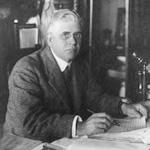The first Commonwealth Meteorologist: the farsighted legacy of Henry A. Hunt
07 February 2012
Ever since William Dawes built his famous observatory at Sydney Cove in 1788, a long line of colourful characters have laid claim to the title of Australia's first weatherman. But it was not until the Bureau of Meteorology started issuing its national weather forecasts on 1 January 1908, that the country officially had its first 'Commonwealth Meteorologist', Henry Ambrose Hunt.
Hunt had been appointed the Bureau's founding director on 1 January 1907, and spent his first year consolidating the disparate services and forecasting methodologies of the various State meteorology services. The result was a system of daily press reports, morse code transmissions, and even flags on tall buildings, which formed the foundation of what would become one of the world's most respected weather forecasting systems.
During his 24 years at the Bureau, Henry Hunt pioneered a number of groundbreaking theories and methodologies for classifying, measuring and monitoring Australia's distinctive weather patterns.
His meteorological career started soon after his family migrated to Australia from Britain, when, in 1886, aged just 19, he began working as an assistant to the influential government astronomer, Henry Chamberlain Russell, at the Sydney Observatory. In 1888, he transferred to the Meteorological Department, where he gradually rose through the ranks, preparing the 'daily weather maps' and eventually becoming Acting Meteorologist in 1904. By late 1906, he was a natural choice to head up the newly formed Commonwealth Meteorological Bureau in Melbourne.

Director of Meteorology, Henry A. Hunt addressing staff at the Central Weather Bureau (Bureau of Meteorology Head Office, Melbourne, 1931). Photograph from the Bureau of Meteorology's image archives.
During his career, Hunt wrote a number of landmark papers that sought to explain Australia's unique weather and atmospheric phenomena. His Essay on Southerly Bursters, which analysed the dramatic summer storms on the New South Wales coast, was awarded the Ralph Abercromby Prize in 1894, and the following year he attracted further acclaim for a pioneering study of 20 different Types of Australian Weather.
After the Bureau began exploring the upper atmosphere with kites in 1913, Hunt co-authored The Climate and Weather of Australia, which is recognised as the first authoritative textbook on Australian meteorology. He is also remembered for a number of prescient theories on Australia's climate, including the intrinsic links between rainfall, temperature and vegetation in influencing droughts and seasonal weather patterns.
Henry Hunt led the Bureau through some of its toughest times, including World War I and the Great Depression, when the organisation suffered personnel and budget cuts despite growing demands for its services. Despite these trials, however, his tenure included some major meteorological milestones, including the establishment of weather stations at Macquarie Island and Willis Island, and the introduction of radio weather forecasts in 1924.
Often described as the pre-eminent forecaster of his time, Hunt's estimated forecast 'strike rate' was an impressive 87 per cent. A quiet and mild-mannered man, he was also a skilled carpenter and mechanic, and invented a number of unique mechanical devices, including a 'rotating rain clock' and a pressure-cube anemometer, which was used to record wind pressure, velocity and direction at the Bureau.
Henry Hunt remained at the Bureau until his retirement in February 1931. He died at his home in Elwood, Melbourne, on 7 February 1946 – his 80th birthday.


Comment. Tell us what you think of this article.
Share. Tell others.